Plastic Pollution, Circular Economy and Schneider Electric
VerifiedAdded on 2023/01/12
|9
|3724
|79
Report
AI Summary
This report delves into the critical issue of plastic pollution, exploring its causes, including overuse, disposable problems, sea accidents, and consumer behavior, and its devastating effects on the planet, including oceans, human health, wildlife, and the economy. It then defines and explains the circular economy model, referencing concepts like Cradle to Cradle and the blue economy, and assesses its influence on the characteristics of a common vision for plastics. The report evaluates Schneider Electric's performance in relation to these characteristics, highlighting its efforts to address plastic pollution and promote sustainability. The analysis covers the company's initiatives in energy management and automated solutions, and its commitment to circular economy principles, providing a comprehensive overview of the challenges and opportunities in combating plastic pollution within a business context.

Ethics Sustainability
and Social Impact
and Social Impact
Paraphrase This Document
Need a fresh take? Get an instant paraphrase of this document with our AI Paraphraser
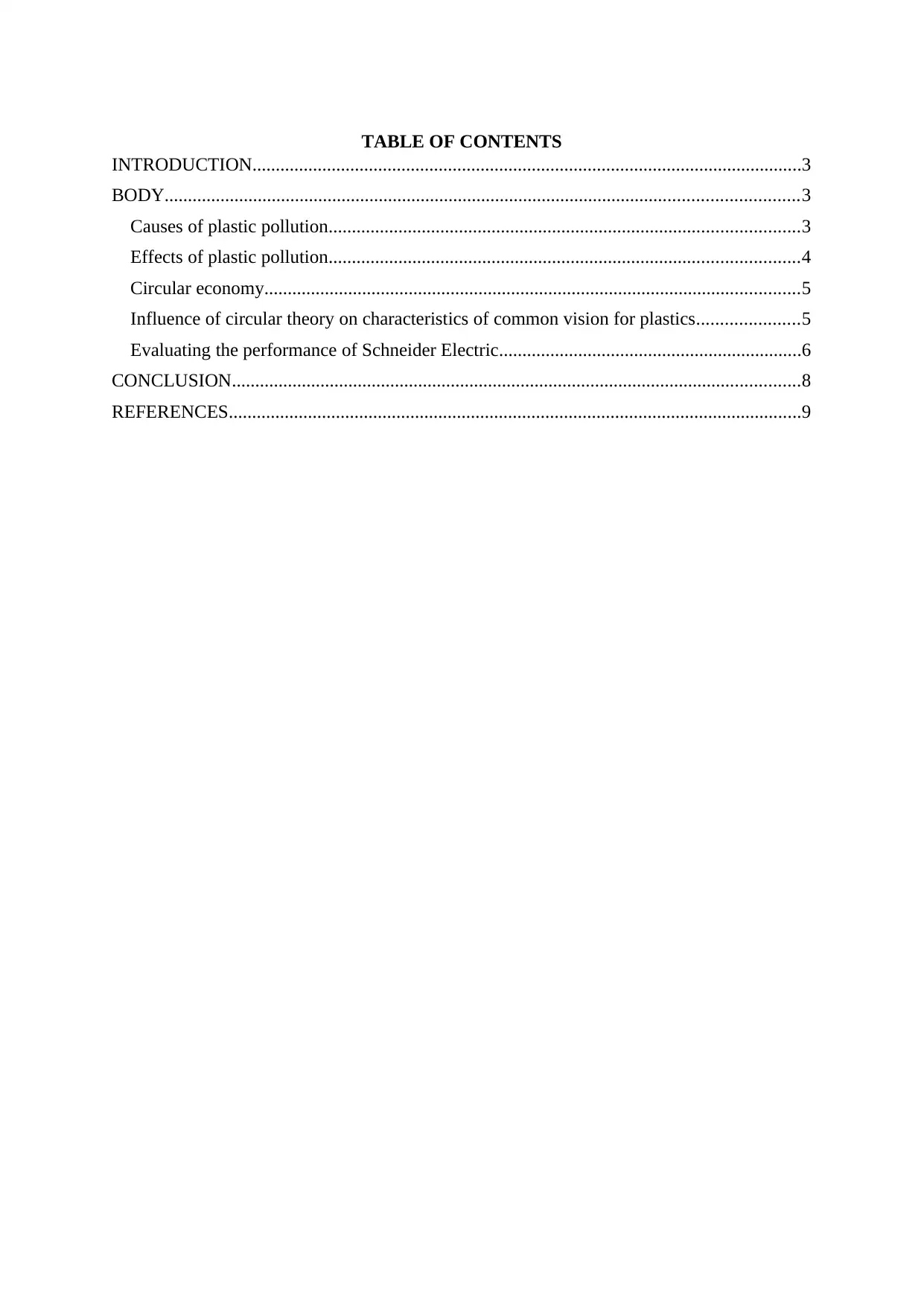
TABLE OF CONTENTS
INTRODUCTION......................................................................................................................3
BODY........................................................................................................................................3
Causes of plastic pollution.....................................................................................................3
Effects of plastic pollution.....................................................................................................4
Circular economy...................................................................................................................5
Influence of circular theory on characteristics of common vision for plastics......................5
Evaluating the performance of Schneider Electric.................................................................6
CONCLUSION..........................................................................................................................8
REFERENCES...........................................................................................................................9
INTRODUCTION......................................................................................................................3
BODY........................................................................................................................................3
Causes of plastic pollution.....................................................................................................3
Effects of plastic pollution.....................................................................................................4
Circular economy...................................................................................................................5
Influence of circular theory on characteristics of common vision for plastics......................5
Evaluating the performance of Schneider Electric.................................................................6
CONCLUSION..........................................................................................................................8
REFERENCES...........................................................................................................................9
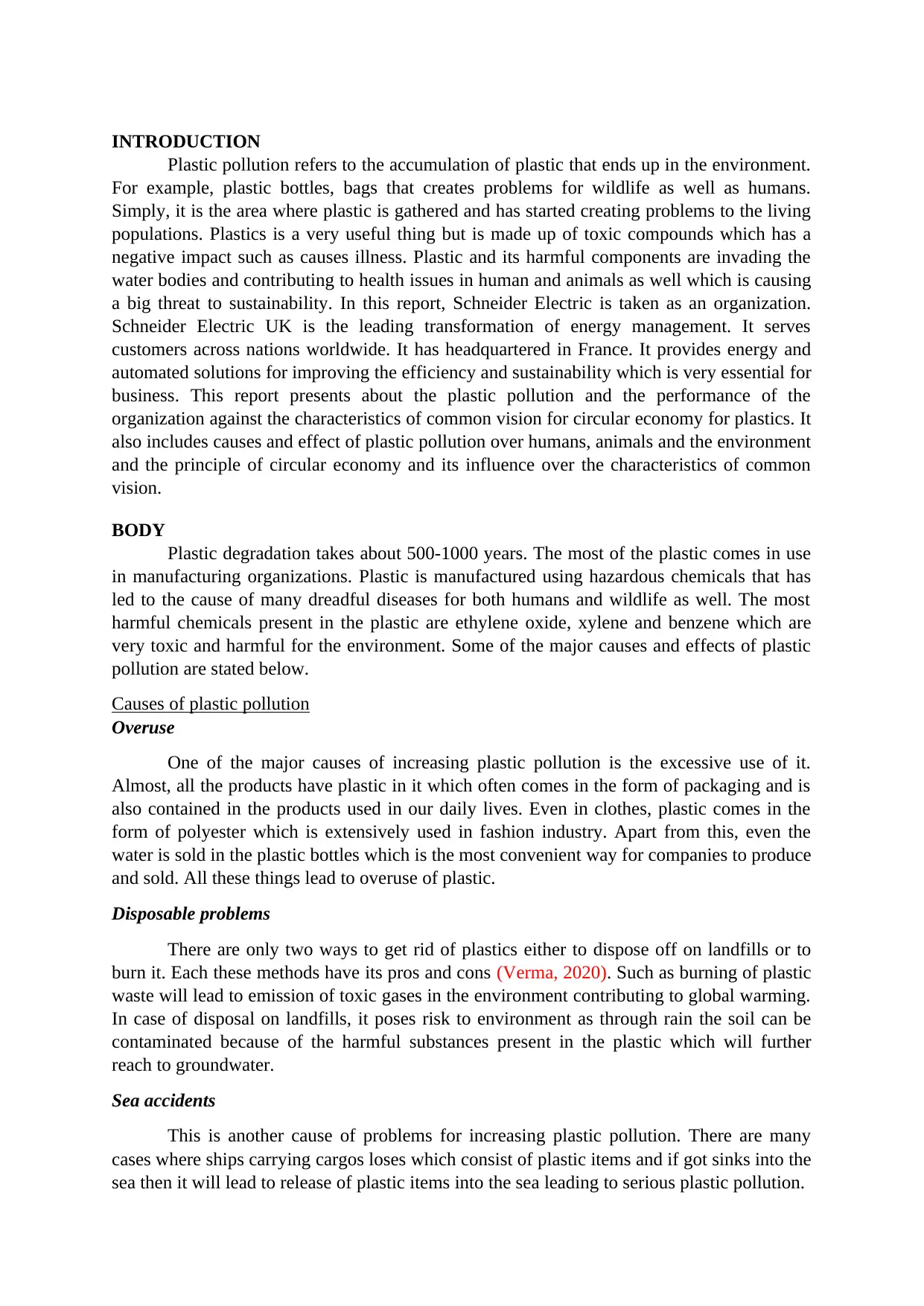
INTRODUCTION
Plastic pollution refers to the accumulation of plastic that ends up in the environment.
For example, plastic bottles, bags that creates problems for wildlife as well as humans.
Simply, it is the area where plastic is gathered and has started creating problems to the living
populations. Plastics is a very useful thing but is made up of toxic compounds which has a
negative impact such as causes illness. Plastic and its harmful components are invading the
water bodies and contributing to health issues in human and animals as well which is causing
a big threat to sustainability. In this report, Schneider Electric is taken as an organization.
Schneider Electric UK is the leading transformation of energy management. It serves
customers across nations worldwide. It has headquartered in France. It provides energy and
automated solutions for improving the efficiency and sustainability which is very essential for
business. This report presents about the plastic pollution and the performance of the
organization against the characteristics of common vision for circular economy for plastics. It
also includes causes and effect of plastic pollution over humans, animals and the environment
and the principle of circular economy and its influence over the characteristics of common
vision.
BODY
Plastic degradation takes about 500-1000 years. The most of the plastic comes in use
in manufacturing organizations. Plastic is manufactured using hazardous chemicals that has
led to the cause of many dreadful diseases for both humans and wildlife as well. The most
harmful chemicals present in the plastic are ethylene oxide, xylene and benzene which are
very toxic and harmful for the environment. Some of the major causes and effects of plastic
pollution are stated below.
Causes of plastic pollution
Overuse
One of the major causes of increasing plastic pollution is the excessive use of it.
Almost, all the products have plastic in it which often comes in the form of packaging and is
also contained in the products used in our daily lives. Even in clothes, plastic comes in the
form of polyester which is extensively used in fashion industry. Apart from this, even the
water is sold in the plastic bottles which is the most convenient way for companies to produce
and sold. All these things lead to overuse of plastic.
Disposable problems
There are only two ways to get rid of plastics either to dispose off on landfills or to
burn it. Each these methods have its pros and cons (Verma, 2020). Such as burning of plastic
waste will lead to emission of toxic gases in the environment contributing to global warming.
In case of disposal on landfills, it poses risk to environment as through rain the soil can be
contaminated because of the harmful substances present in the plastic which will further
reach to groundwater.
Sea accidents
This is another cause of problems for increasing plastic pollution. There are many
cases where ships carrying cargos loses which consist of plastic items and if got sinks into the
sea then it will lead to release of plastic items into the sea leading to serious plastic pollution.
Plastic pollution refers to the accumulation of plastic that ends up in the environment.
For example, plastic bottles, bags that creates problems for wildlife as well as humans.
Simply, it is the area where plastic is gathered and has started creating problems to the living
populations. Plastics is a very useful thing but is made up of toxic compounds which has a
negative impact such as causes illness. Plastic and its harmful components are invading the
water bodies and contributing to health issues in human and animals as well which is causing
a big threat to sustainability. In this report, Schneider Electric is taken as an organization.
Schneider Electric UK is the leading transformation of energy management. It serves
customers across nations worldwide. It has headquartered in France. It provides energy and
automated solutions for improving the efficiency and sustainability which is very essential for
business. This report presents about the plastic pollution and the performance of the
organization against the characteristics of common vision for circular economy for plastics. It
also includes causes and effect of plastic pollution over humans, animals and the environment
and the principle of circular economy and its influence over the characteristics of common
vision.
BODY
Plastic degradation takes about 500-1000 years. The most of the plastic comes in use
in manufacturing organizations. Plastic is manufactured using hazardous chemicals that has
led to the cause of many dreadful diseases for both humans and wildlife as well. The most
harmful chemicals present in the plastic are ethylene oxide, xylene and benzene which are
very toxic and harmful for the environment. Some of the major causes and effects of plastic
pollution are stated below.
Causes of plastic pollution
Overuse
One of the major causes of increasing plastic pollution is the excessive use of it.
Almost, all the products have plastic in it which often comes in the form of packaging and is
also contained in the products used in our daily lives. Even in clothes, plastic comes in the
form of polyester which is extensively used in fashion industry. Apart from this, even the
water is sold in the plastic bottles which is the most convenient way for companies to produce
and sold. All these things lead to overuse of plastic.
Disposable problems
There are only two ways to get rid of plastics either to dispose off on landfills or to
burn it. Each these methods have its pros and cons (Verma, 2020). Such as burning of plastic
waste will lead to emission of toxic gases in the environment contributing to global warming.
In case of disposal on landfills, it poses risk to environment as through rain the soil can be
contaminated because of the harmful substances present in the plastic which will further
reach to groundwater.
Sea accidents
This is another cause of problems for increasing plastic pollution. There are many
cases where ships carrying cargos loses which consist of plastic items and if got sinks into the
sea then it will lead to release of plastic items into the sea leading to serious plastic pollution.
⊘ This is a preview!⊘
Do you want full access?
Subscribe today to unlock all pages.

Trusted by 1+ million students worldwide
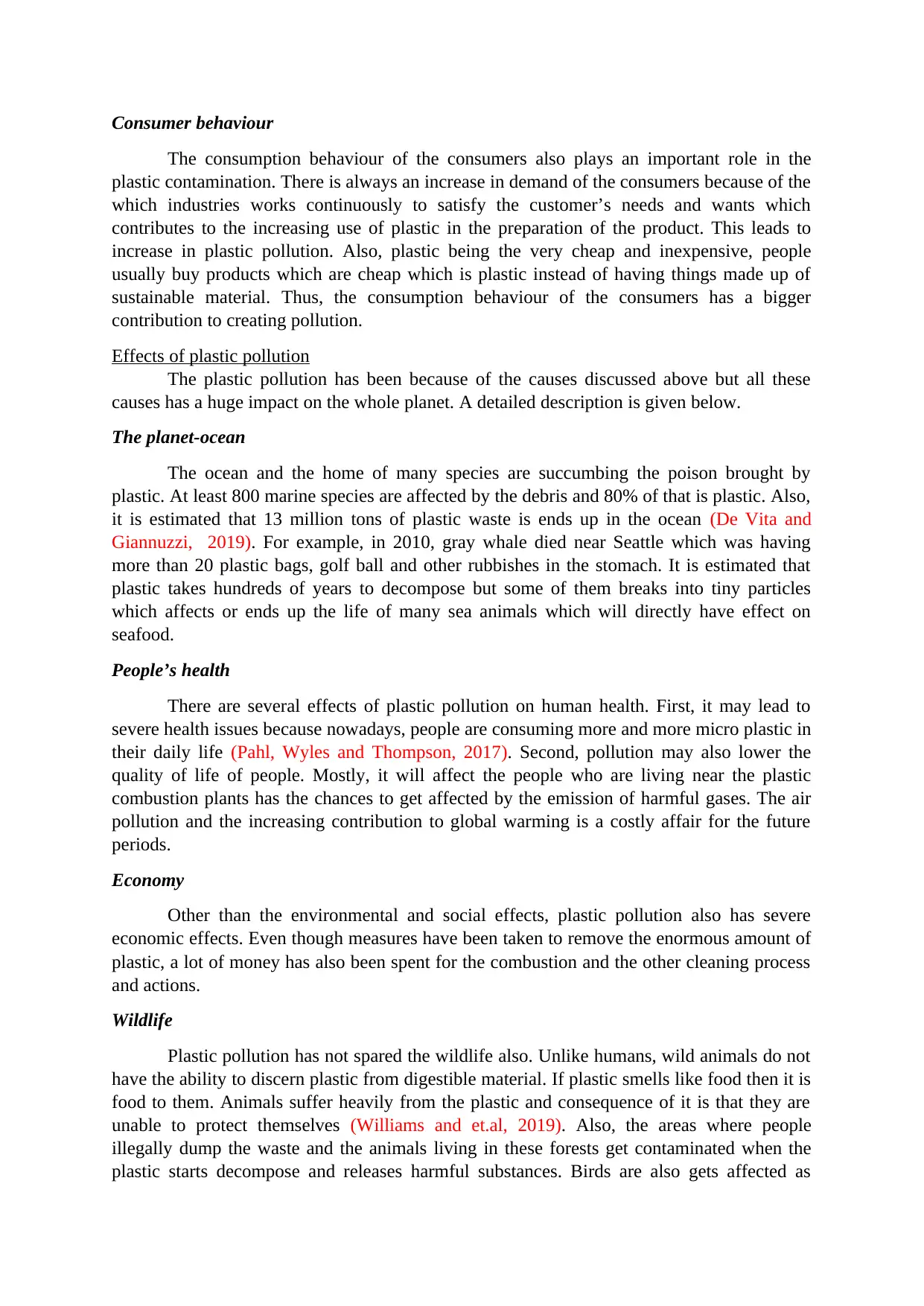
Consumer behaviour
The consumption behaviour of the consumers also plays an important role in the
plastic contamination. There is always an increase in demand of the consumers because of the
which industries works continuously to satisfy the customer’s needs and wants which
contributes to the increasing use of plastic in the preparation of the product. This leads to
increase in plastic pollution. Also, plastic being the very cheap and inexpensive, people
usually buy products which are cheap which is plastic instead of having things made up of
sustainable material. Thus, the consumption behaviour of the consumers has a bigger
contribution to creating pollution.
Effects of plastic pollution
The plastic pollution has been because of the causes discussed above but all these
causes has a huge impact on the whole planet. A detailed description is given below.
The planet-ocean
The ocean and the home of many species are succumbing the poison brought by
plastic. At least 800 marine species are affected by the debris and 80% of that is plastic. Also,
it is estimated that 13 million tons of plastic waste is ends up in the ocean (De Vita and
Giannuzzi, 2019). For example, in 2010, gray whale died near Seattle which was having
more than 20 plastic bags, golf ball and other rubbishes in the stomach. It is estimated that
plastic takes hundreds of years to decompose but some of them breaks into tiny particles
which affects or ends up the life of many sea animals which will directly have effect on
seafood.
People’s health
There are several effects of plastic pollution on human health. First, it may lead to
severe health issues because nowadays, people are consuming more and more micro plastic in
their daily life (Pahl, Wyles and Thompson, 2017). Second, pollution may also lower the
quality of life of people. Mostly, it will affect the people who are living near the plastic
combustion plants has the chances to get affected by the emission of harmful gases. The air
pollution and the increasing contribution to global warming is a costly affair for the future
periods.
Economy
Other than the environmental and social effects, plastic pollution also has severe
economic effects. Even though measures have been taken to remove the enormous amount of
plastic, a lot of money has also been spent for the combustion and the other cleaning process
and actions.
Wildlife
Plastic pollution has not spared the wildlife also. Unlike humans, wild animals do not
have the ability to discern plastic from digestible material. If plastic smells like food then it is
food to them. Animals suffer heavily from the plastic and consequence of it is that they are
unable to protect themselves (Williams and et.al, 2019). Also, the areas where people
illegally dump the waste and the animals living in these forests get contaminated when the
plastic starts decompose and releases harmful substances. Birds are also gets affected as
The consumption behaviour of the consumers also plays an important role in the
plastic contamination. There is always an increase in demand of the consumers because of the
which industries works continuously to satisfy the customer’s needs and wants which
contributes to the increasing use of plastic in the preparation of the product. This leads to
increase in plastic pollution. Also, plastic being the very cheap and inexpensive, people
usually buy products which are cheap which is plastic instead of having things made up of
sustainable material. Thus, the consumption behaviour of the consumers has a bigger
contribution to creating pollution.
Effects of plastic pollution
The plastic pollution has been because of the causes discussed above but all these
causes has a huge impact on the whole planet. A detailed description is given below.
The planet-ocean
The ocean and the home of many species are succumbing the poison brought by
plastic. At least 800 marine species are affected by the debris and 80% of that is plastic. Also,
it is estimated that 13 million tons of plastic waste is ends up in the ocean (De Vita and
Giannuzzi, 2019). For example, in 2010, gray whale died near Seattle which was having
more than 20 plastic bags, golf ball and other rubbishes in the stomach. It is estimated that
plastic takes hundreds of years to decompose but some of them breaks into tiny particles
which affects or ends up the life of many sea animals which will directly have effect on
seafood.
People’s health
There are several effects of plastic pollution on human health. First, it may lead to
severe health issues because nowadays, people are consuming more and more micro plastic in
their daily life (Pahl, Wyles and Thompson, 2017). Second, pollution may also lower the
quality of life of people. Mostly, it will affect the people who are living near the plastic
combustion plants has the chances to get affected by the emission of harmful gases. The air
pollution and the increasing contribution to global warming is a costly affair for the future
periods.
Economy
Other than the environmental and social effects, plastic pollution also has severe
economic effects. Even though measures have been taken to remove the enormous amount of
plastic, a lot of money has also been spent for the combustion and the other cleaning process
and actions.
Wildlife
Plastic pollution has not spared the wildlife also. Unlike humans, wild animals do not
have the ability to discern plastic from digestible material. If plastic smells like food then it is
food to them. Animals suffer heavily from the plastic and consequence of it is that they are
unable to protect themselves (Williams and et.al, 2019). Also, the areas where people
illegally dump the waste and the animals living in these forests get contaminated when the
plastic starts decompose and releases harmful substances. Birds are also gets affected as
Paraphrase This Document
Need a fresh take? Get an instant paraphrase of this document with our AI Paraphraser
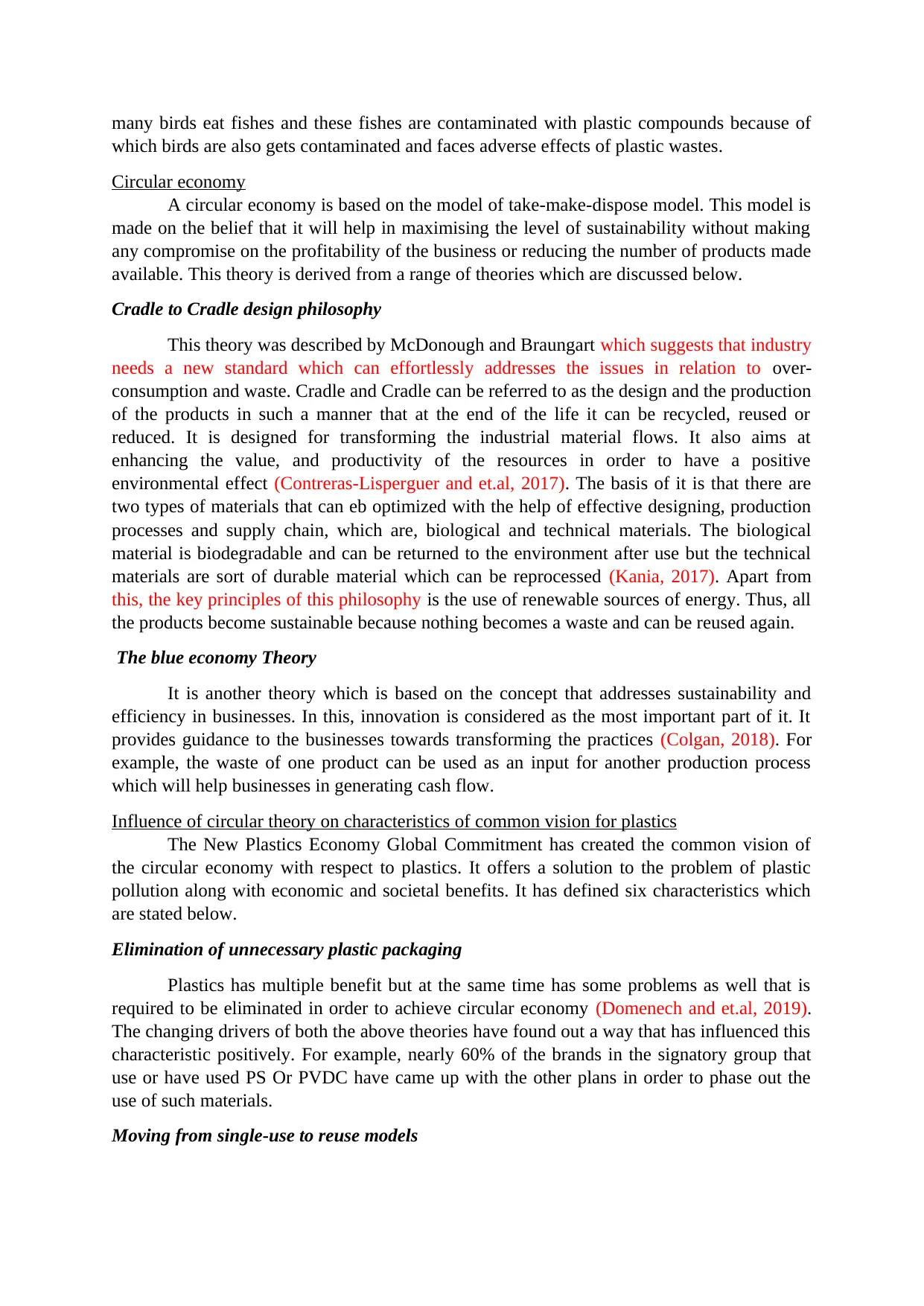
many birds eat fishes and these fishes are contaminated with plastic compounds because of
which birds are also gets contaminated and faces adverse effects of plastic wastes.
Circular economy
A circular economy is based on the model of take-make-dispose model. This model is
made on the belief that it will help in maximising the level of sustainability without making
any compromise on the profitability of the business or reducing the number of products made
available. This theory is derived from a range of theories which are discussed below.
Cradle to Cradle design philosophy
This theory was described by McDonough and Braungart which suggests that industry
needs a new standard which can effortlessly addresses the issues in relation to over-
consumption and waste. Cradle and Cradle can be referred to as the design and the production
of the products in such a manner that at the end of the life it can be recycled, reused or
reduced. It is designed for transforming the industrial material flows. It also aims at
enhancing the value, and productivity of the resources in order to have a positive
environmental effect (Contreras-Lisperguer and et.al, 2017). The basis of it is that there are
two types of materials that can eb optimized with the help of effective designing, production
processes and supply chain, which are, biological and technical materials. The biological
material is biodegradable and can be returned to the environment after use but the technical
materials are sort of durable material which can be reprocessed (Kania, 2017). Apart from
this, the key principles of this philosophy is the use of renewable sources of energy. Thus, all
the products become sustainable because nothing becomes a waste and can be reused again.
The blue economy Theory
It is another theory which is based on the concept that addresses sustainability and
efficiency in businesses. In this, innovation is considered as the most important part of it. It
provides guidance to the businesses towards transforming the practices (Colgan, 2018). For
example, the waste of one product can be used as an input for another production process
which will help businesses in generating cash flow.
Influence of circular theory on characteristics of common vision for plastics
The New Plastics Economy Global Commitment has created the common vision of
the circular economy with respect to plastics. It offers a solution to the problem of plastic
pollution along with economic and societal benefits. It has defined six characteristics which
are stated below.
Elimination of unnecessary plastic packaging
Plastics has multiple benefit but at the same time has some problems as well that is
required to be eliminated in order to achieve circular economy (Domenech and et.al, 2019).
The changing drivers of both the above theories have found out a way that has influenced this
characteristic positively. For example, nearly 60% of the brands in the signatory group that
use or have used PS Or PVDC have came up with the other plans in order to phase out the
use of such materials.
Moving from single-use to reuse models
which birds are also gets contaminated and faces adverse effects of plastic wastes.
Circular economy
A circular economy is based on the model of take-make-dispose model. This model is
made on the belief that it will help in maximising the level of sustainability without making
any compromise on the profitability of the business or reducing the number of products made
available. This theory is derived from a range of theories which are discussed below.
Cradle to Cradle design philosophy
This theory was described by McDonough and Braungart which suggests that industry
needs a new standard which can effortlessly addresses the issues in relation to over-
consumption and waste. Cradle and Cradle can be referred to as the design and the production
of the products in such a manner that at the end of the life it can be recycled, reused or
reduced. It is designed for transforming the industrial material flows. It also aims at
enhancing the value, and productivity of the resources in order to have a positive
environmental effect (Contreras-Lisperguer and et.al, 2017). The basis of it is that there are
two types of materials that can eb optimized with the help of effective designing, production
processes and supply chain, which are, biological and technical materials. The biological
material is biodegradable and can be returned to the environment after use but the technical
materials are sort of durable material which can be reprocessed (Kania, 2017). Apart from
this, the key principles of this philosophy is the use of renewable sources of energy. Thus, all
the products become sustainable because nothing becomes a waste and can be reused again.
The blue economy Theory
It is another theory which is based on the concept that addresses sustainability and
efficiency in businesses. In this, innovation is considered as the most important part of it. It
provides guidance to the businesses towards transforming the practices (Colgan, 2018). For
example, the waste of one product can be used as an input for another production process
which will help businesses in generating cash flow.
Influence of circular theory on characteristics of common vision for plastics
The New Plastics Economy Global Commitment has created the common vision of
the circular economy with respect to plastics. It offers a solution to the problem of plastic
pollution along with economic and societal benefits. It has defined six characteristics which
are stated below.
Elimination of unnecessary plastic packaging
Plastics has multiple benefit but at the same time has some problems as well that is
required to be eliminated in order to achieve circular economy (Domenech and et.al, 2019).
The changing drivers of both the above theories have found out a way that has influenced this
characteristic positively. For example, nearly 60% of the brands in the signatory group that
use or have used PS Or PVDC have came up with the other plans in order to phase out the
use of such materials.
Moving from single-use to reuse models
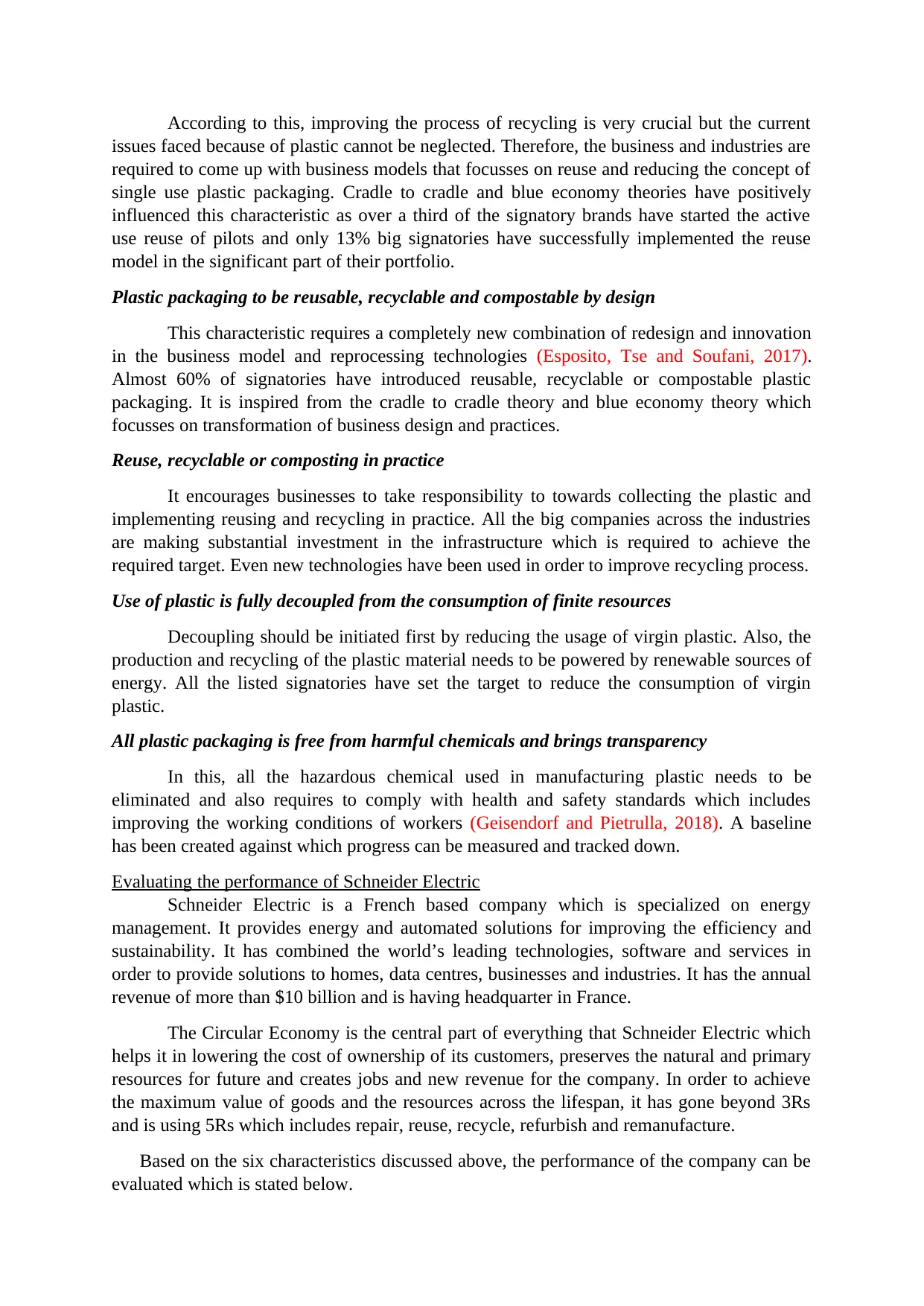
According to this, improving the process of recycling is very crucial but the current
issues faced because of plastic cannot be neglected. Therefore, the business and industries are
required to come up with business models that focusses on reuse and reducing the concept of
single use plastic packaging. Cradle to cradle and blue economy theories have positively
influenced this characteristic as over a third of the signatory brands have started the active
use reuse of pilots and only 13% big signatories have successfully implemented the reuse
model in the significant part of their portfolio.
Plastic packaging to be reusable, recyclable and compostable by design
This characteristic requires a completely new combination of redesign and innovation
in the business model and reprocessing technologies (Esposito, Tse and Soufani, 2017).
Almost 60% of signatories have introduced reusable, recyclable or compostable plastic
packaging. It is inspired from the cradle to cradle theory and blue economy theory which
focusses on transformation of business design and practices.
Reuse, recyclable or composting in practice
It encourages businesses to take responsibility to towards collecting the plastic and
implementing reusing and recycling in practice. All the big companies across the industries
are making substantial investment in the infrastructure which is required to achieve the
required target. Even new technologies have been used in order to improve recycling process.
Use of plastic is fully decoupled from the consumption of finite resources
Decoupling should be initiated first by reducing the usage of virgin plastic. Also, the
production and recycling of the plastic material needs to be powered by renewable sources of
energy. All the listed signatories have set the target to reduce the consumption of virgin
plastic.
All plastic packaging is free from harmful chemicals and brings transparency
In this, all the hazardous chemical used in manufacturing plastic needs to be
eliminated and also requires to comply with health and safety standards which includes
improving the working conditions of workers (Geisendorf and Pietrulla, 2018). A baseline
has been created against which progress can be measured and tracked down.
Evaluating the performance of Schneider Electric
Schneider Electric is a French based company which is specialized on energy
management. It provides energy and automated solutions for improving the efficiency and
sustainability. It has combined the world’s leading technologies, software and services in
order to provide solutions to homes, data centres, businesses and industries. It has the annual
revenue of more than $10 billion and is having headquarter in France.
The Circular Economy is the central part of everything that Schneider Electric which
helps it in lowering the cost of ownership of its customers, preserves the natural and primary
resources for future and creates jobs and new revenue for the company. In order to achieve
the maximum value of goods and the resources across the lifespan, it has gone beyond 3Rs
and is using 5Rs which includes repair, reuse, recycle, refurbish and remanufacture.
Based on the six characteristics discussed above, the performance of the company can be
evaluated which is stated below.
issues faced because of plastic cannot be neglected. Therefore, the business and industries are
required to come up with business models that focusses on reuse and reducing the concept of
single use plastic packaging. Cradle to cradle and blue economy theories have positively
influenced this characteristic as over a third of the signatory brands have started the active
use reuse of pilots and only 13% big signatories have successfully implemented the reuse
model in the significant part of their portfolio.
Plastic packaging to be reusable, recyclable and compostable by design
This characteristic requires a completely new combination of redesign and innovation
in the business model and reprocessing technologies (Esposito, Tse and Soufani, 2017).
Almost 60% of signatories have introduced reusable, recyclable or compostable plastic
packaging. It is inspired from the cradle to cradle theory and blue economy theory which
focusses on transformation of business design and practices.
Reuse, recyclable or composting in practice
It encourages businesses to take responsibility to towards collecting the plastic and
implementing reusing and recycling in practice. All the big companies across the industries
are making substantial investment in the infrastructure which is required to achieve the
required target. Even new technologies have been used in order to improve recycling process.
Use of plastic is fully decoupled from the consumption of finite resources
Decoupling should be initiated first by reducing the usage of virgin plastic. Also, the
production and recycling of the plastic material needs to be powered by renewable sources of
energy. All the listed signatories have set the target to reduce the consumption of virgin
plastic.
All plastic packaging is free from harmful chemicals and brings transparency
In this, all the hazardous chemical used in manufacturing plastic needs to be
eliminated and also requires to comply with health and safety standards which includes
improving the working conditions of workers (Geisendorf and Pietrulla, 2018). A baseline
has been created against which progress can be measured and tracked down.
Evaluating the performance of Schneider Electric
Schneider Electric is a French based company which is specialized on energy
management. It provides energy and automated solutions for improving the efficiency and
sustainability. It has combined the world’s leading technologies, software and services in
order to provide solutions to homes, data centres, businesses and industries. It has the annual
revenue of more than $10 billion and is having headquarter in France.
The Circular Economy is the central part of everything that Schneider Electric which
helps it in lowering the cost of ownership of its customers, preserves the natural and primary
resources for future and creates jobs and new revenue for the company. In order to achieve
the maximum value of goods and the resources across the lifespan, it has gone beyond 3Rs
and is using 5Rs which includes repair, reuse, recycle, refurbish and remanufacture.
Based on the six characteristics discussed above, the performance of the company can be
evaluated which is stated below.
⊘ This is a preview!⊘
Do you want full access?
Subscribe today to unlock all pages.

Trusted by 1+ million students worldwide
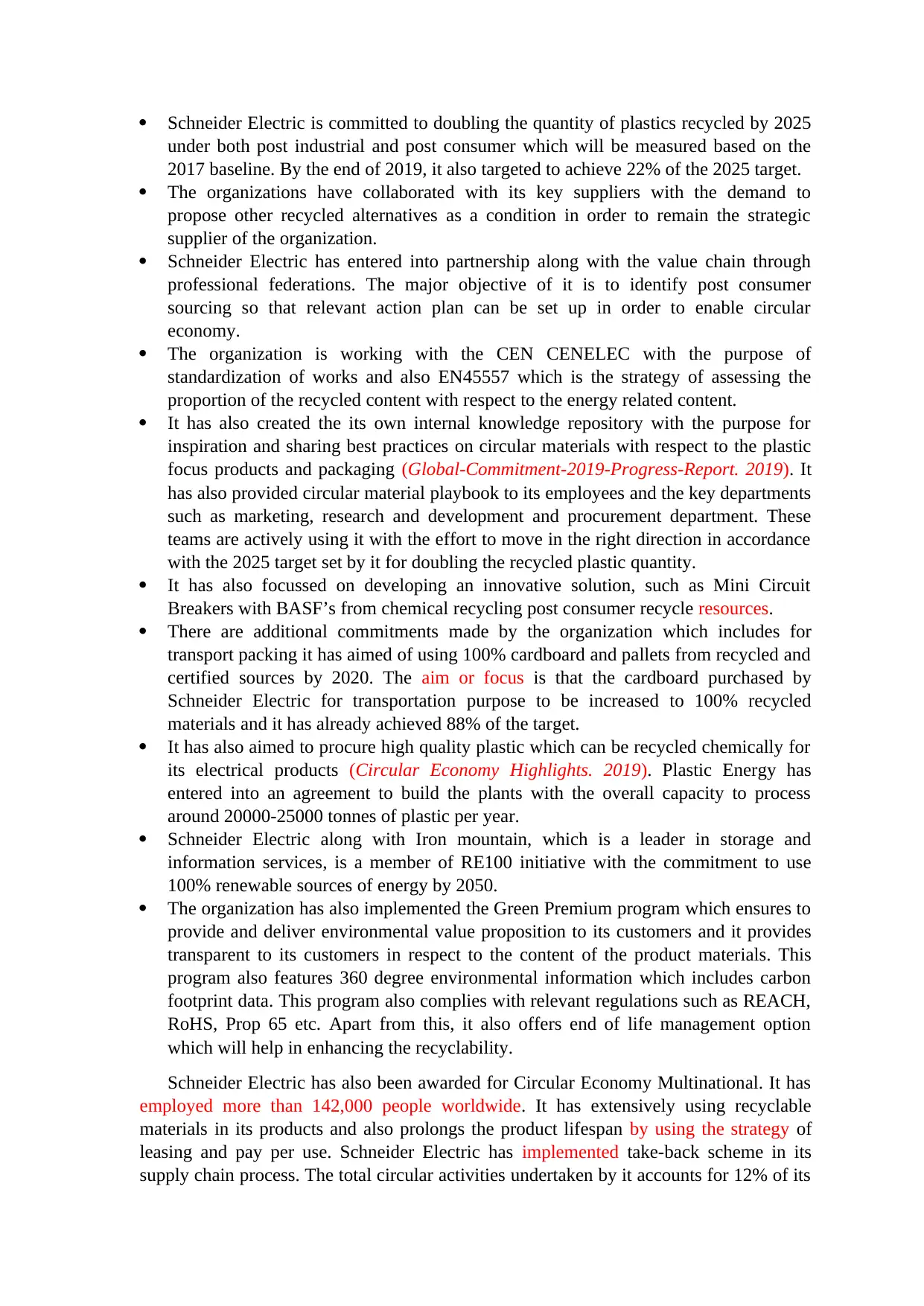
Schneider Electric is committed to doubling the quantity of plastics recycled by 2025
under both post industrial and post consumer which will be measured based on the
2017 baseline. By the end of 2019, it also targeted to achieve 22% of the 2025 target.
The organizations have collaborated with its key suppliers with the demand to
propose other recycled alternatives as a condition in order to remain the strategic
supplier of the organization.
Schneider Electric has entered into partnership along with the value chain through
professional federations. The major objective of it is to identify post consumer
sourcing so that relevant action plan can be set up in order to enable circular
economy.
The organization is working with the CEN CENELEC with the purpose of
standardization of works and also EN45557 which is the strategy of assessing the
proportion of the recycled content with respect to the energy related content.
It has also created the its own internal knowledge repository with the purpose for
inspiration and sharing best practices on circular materials with respect to the plastic
focus products and packaging (Global-Commitment-2019-Progress-Report. 2019). It
has also provided circular material playbook to its employees and the key departments
such as marketing, research and development and procurement department. These
teams are actively using it with the effort to move in the right direction in accordance
with the 2025 target set by it for doubling the recycled plastic quantity.
It has also focussed on developing an innovative solution, such as Mini Circuit
Breakers with BASF’s from chemical recycling post consumer recycle resources.
There are additional commitments made by the organization which includes for
transport packing it has aimed of using 100% cardboard and pallets from recycled and
certified sources by 2020. The aim or focus is that the cardboard purchased by
Schneider Electric for transportation purpose to be increased to 100% recycled
materials and it has already achieved 88% of the target.
It has also aimed to procure high quality plastic which can be recycled chemically for
its electrical products (Circular Economy Highlights. 2019). Plastic Energy has
entered into an agreement to build the plants with the overall capacity to process
around 20000-25000 tonnes of plastic per year.
Schneider Electric along with Iron mountain, which is a leader in storage and
information services, is a member of RE100 initiative with the commitment to use
100% renewable sources of energy by 2050.
The organization has also implemented the Green Premium program which ensures to
provide and deliver environmental value proposition to its customers and it provides
transparent to its customers in respect to the content of the product materials. This
program also features 360 degree environmental information which includes carbon
footprint data. This program also complies with relevant regulations such as REACH,
RoHS, Prop 65 etc. Apart from this, it also offers end of life management option
which will help in enhancing the recyclability.
Schneider Electric has also been awarded for Circular Economy Multinational. It has
employed more than 142,000 people worldwide. It has extensively using recyclable
materials in its products and also prolongs the product lifespan by using the strategy of
leasing and pay per use. Schneider Electric has implemented take-back scheme in its
supply chain process. The total circular activities undertaken by it accounts for 12% of its
under both post industrial and post consumer which will be measured based on the
2017 baseline. By the end of 2019, it also targeted to achieve 22% of the 2025 target.
The organizations have collaborated with its key suppliers with the demand to
propose other recycled alternatives as a condition in order to remain the strategic
supplier of the organization.
Schneider Electric has entered into partnership along with the value chain through
professional federations. The major objective of it is to identify post consumer
sourcing so that relevant action plan can be set up in order to enable circular
economy.
The organization is working with the CEN CENELEC with the purpose of
standardization of works and also EN45557 which is the strategy of assessing the
proportion of the recycled content with respect to the energy related content.
It has also created the its own internal knowledge repository with the purpose for
inspiration and sharing best practices on circular materials with respect to the plastic
focus products and packaging (Global-Commitment-2019-Progress-Report. 2019). It
has also provided circular material playbook to its employees and the key departments
such as marketing, research and development and procurement department. These
teams are actively using it with the effort to move in the right direction in accordance
with the 2025 target set by it for doubling the recycled plastic quantity.
It has also focussed on developing an innovative solution, such as Mini Circuit
Breakers with BASF’s from chemical recycling post consumer recycle resources.
There are additional commitments made by the organization which includes for
transport packing it has aimed of using 100% cardboard and pallets from recycled and
certified sources by 2020. The aim or focus is that the cardboard purchased by
Schneider Electric for transportation purpose to be increased to 100% recycled
materials and it has already achieved 88% of the target.
It has also aimed to procure high quality plastic which can be recycled chemically for
its electrical products (Circular Economy Highlights. 2019). Plastic Energy has
entered into an agreement to build the plants with the overall capacity to process
around 20000-25000 tonnes of plastic per year.
Schneider Electric along with Iron mountain, which is a leader in storage and
information services, is a member of RE100 initiative with the commitment to use
100% renewable sources of energy by 2050.
The organization has also implemented the Green Premium program which ensures to
provide and deliver environmental value proposition to its customers and it provides
transparent to its customers in respect to the content of the product materials. This
program also features 360 degree environmental information which includes carbon
footprint data. This program also complies with relevant regulations such as REACH,
RoHS, Prop 65 etc. Apart from this, it also offers end of life management option
which will help in enhancing the recyclability.
Schneider Electric has also been awarded for Circular Economy Multinational. It has
employed more than 142,000 people worldwide. It has extensively using recyclable
materials in its products and also prolongs the product lifespan by using the strategy of
leasing and pay per use. Schneider Electric has implemented take-back scheme in its
supply chain process. The total circular activities undertaken by it accounts for 12% of its
Paraphrase This Document
Need a fresh take? Get an instant paraphrase of this document with our AI Paraphraser

revenue which will help it in saving 100,000 tons of natural and primary resources in the
year 2018-2020.
Thus, it can be said from the above that Schneider Electric has been very active in
implementing circular economy in its system and also taking relevant steps in order to
comply and stick to it. It has been marked in the top 11 companies who re leading ways to
a circular economy. It has successfully followed all the six characteristics laid by The
New Plastics Economy Global Commitment. Schneider Electric has acknowledged the
significant amount of investment and efforts required for aiming better environmental and
economic result.
CONCLUSION
It can be summarized from the above that the plastic has an immense role in
increasing the environmental damage caused by its pollution. The different causes of plastic
pollution were discussed which has thrown light on the key aspects of which are required to
be considered. It includes business practices, consumer behaviour, waste disposal practices,
overuse of plastic etc. which has led to the increase in plastic pollution. But its effect cannot
to explained just by saying plastic pollution but it needs to be pointed out individually on the
basis of its effect on planet, human beings, wildlife and the economy of the country. All the
negative effects it has caused to the environment has increased the awareness among the
people and the organization’s as well which resulted into the process of finding out the
relevant solution to it apart from either to dispose off on landfills or to burn it as both these
methods has negative impact on the environment.
Schneider Electric has taken significant steps for the betterment and welfare of the
environment and economy as a whole. The organization has used circular economy with the
objective to minimize the harmful effect of its product and services on the environment.
Schneider Electric has taken four circular initiatives with the core purpose of offering better
products and services and solutions with very less or minimal harm on the environment or
surroundings. By the end of 2020, it has committed to have 75% sales under its new Green
Premium program. Also, it has targeted and committed to 100,000 metric tons of avoided
primary resource consumption through its ecoFit, recycling and take-back programs. It has
also marked 200 sites for zero waste to landfill initiatives. And the last is the using 100%
cardboard and pallets from certified sources for transport packing. The 6 characteristics of the
New Plastics Economy Global Commitment has been effectively followed by the
organization which can eb seen by its achievement. Apart from this, these 6 characteristics
are created or developed taking into consideration the theory of Cradle to Cradle design
philosophy and the blue economy theory. Thus, it can be said that the organization Schneider
Electric has been sustainable in terms of using its business practices based on the
performance evaluation of the same and it has done exceptional job and even it is still
working hard to make it a huge success.
year 2018-2020.
Thus, it can be said from the above that Schneider Electric has been very active in
implementing circular economy in its system and also taking relevant steps in order to
comply and stick to it. It has been marked in the top 11 companies who re leading ways to
a circular economy. It has successfully followed all the six characteristics laid by The
New Plastics Economy Global Commitment. Schneider Electric has acknowledged the
significant amount of investment and efforts required for aiming better environmental and
economic result.
CONCLUSION
It can be summarized from the above that the plastic has an immense role in
increasing the environmental damage caused by its pollution. The different causes of plastic
pollution were discussed which has thrown light on the key aspects of which are required to
be considered. It includes business practices, consumer behaviour, waste disposal practices,
overuse of plastic etc. which has led to the increase in plastic pollution. But its effect cannot
to explained just by saying plastic pollution but it needs to be pointed out individually on the
basis of its effect on planet, human beings, wildlife and the economy of the country. All the
negative effects it has caused to the environment has increased the awareness among the
people and the organization’s as well which resulted into the process of finding out the
relevant solution to it apart from either to dispose off on landfills or to burn it as both these
methods has negative impact on the environment.
Schneider Electric has taken significant steps for the betterment and welfare of the
environment and economy as a whole. The organization has used circular economy with the
objective to minimize the harmful effect of its product and services on the environment.
Schneider Electric has taken four circular initiatives with the core purpose of offering better
products and services and solutions with very less or minimal harm on the environment or
surroundings. By the end of 2020, it has committed to have 75% sales under its new Green
Premium program. Also, it has targeted and committed to 100,000 metric tons of avoided
primary resource consumption through its ecoFit, recycling and take-back programs. It has
also marked 200 sites for zero waste to landfill initiatives. And the last is the using 100%
cardboard and pallets from certified sources for transport packing. The 6 characteristics of the
New Plastics Economy Global Commitment has been effectively followed by the
organization which can eb seen by its achievement. Apart from this, these 6 characteristics
are created or developed taking into consideration the theory of Cradle to Cradle design
philosophy and the blue economy theory. Thus, it can be said that the organization Schneider
Electric has been sustainable in terms of using its business practices based on the
performance evaluation of the same and it has done exceptional job and even it is still
working hard to make it a huge success.
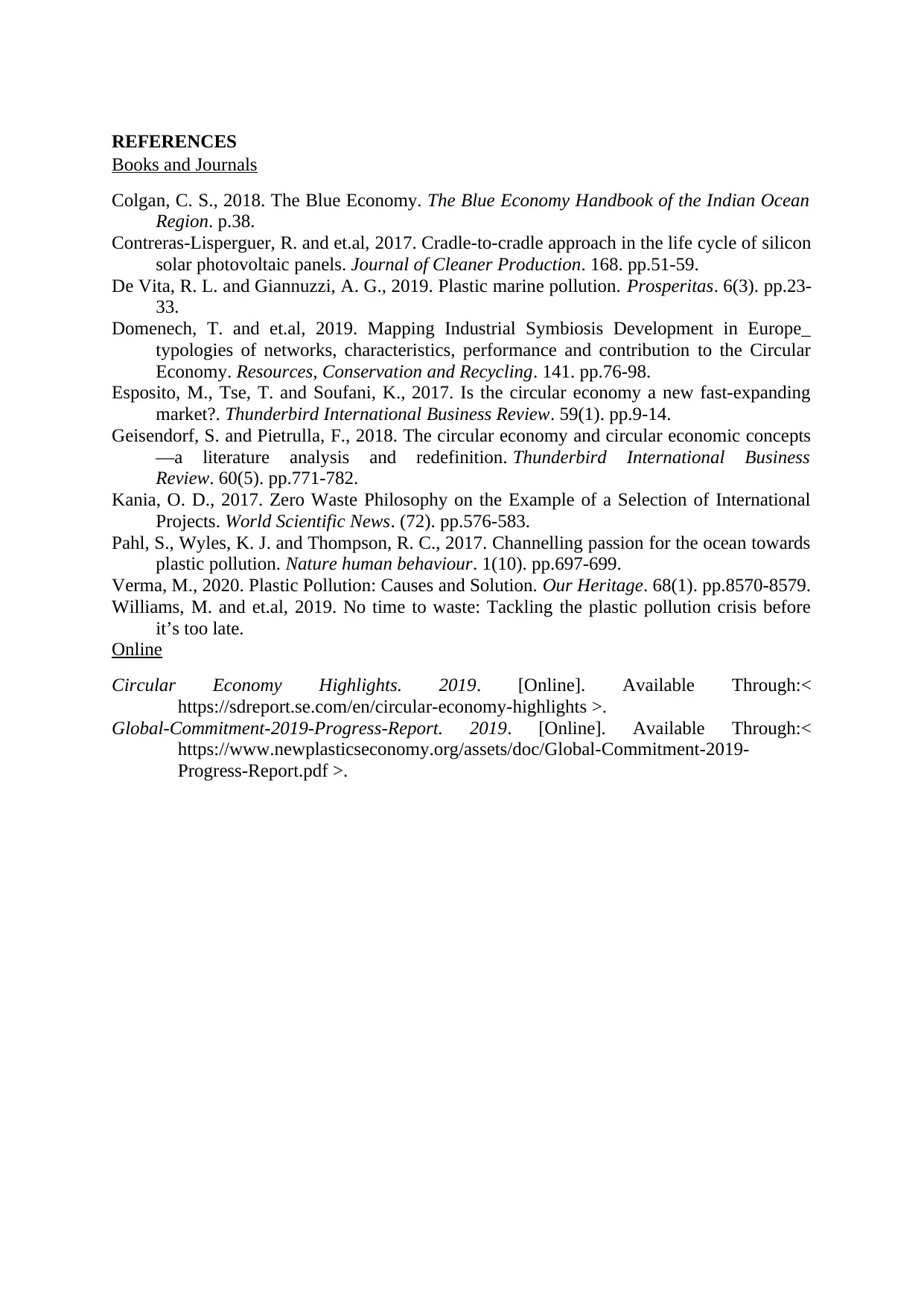
REFERENCES
Books and Journals
Colgan, C. S., 2018. The Blue Economy. The Blue Economy Handbook of the Indian Ocean
Region. p.38.
Contreras-Lisperguer, R. and et.al, 2017. Cradle-to-cradle approach in the life cycle of silicon
solar photovoltaic panels. Journal of Cleaner Production. 168. pp.51-59.
De Vita, R. L. and Giannuzzi, A. G., 2019. Plastic marine pollution. Prosperitas. 6(3). pp.23-
33.
Domenech, T. and et.al, 2019. Mapping Industrial Symbiosis Development in Europe_
typologies of networks, characteristics, performance and contribution to the Circular
Economy. Resources, Conservation and Recycling. 141. pp.76-98.
Esposito, M., Tse, T. and Soufani, K., 2017. Is the circular economy a new fast‐expanding
market?. Thunderbird International Business Review. 59(1). pp.9-14.
Geisendorf, S. and Pietrulla, F., 2018. The circular economy and circular economic concepts
—a literature analysis and redefinition. Thunderbird International Business
Review. 60(5). pp.771-782.
Kania, O. D., 2017. Zero Waste Philosophy on the Example of a Selection of International
Projects. World Scientific News. (72). pp.576-583.
Pahl, S., Wyles, K. J. and Thompson, R. C., 2017. Channelling passion for the ocean towards
plastic pollution. Nature human behaviour. 1(10). pp.697-699.
Verma, M., 2020. Plastic Pollution: Causes and Solution. Our Heritage. 68(1). pp.8570-8579.
Williams, M. and et.al, 2019. No time to waste: Tackling the plastic pollution crisis before
it’s too late.
Online
Circular Economy Highlights. 2019. [Online]. Available Through:<
https://sdreport.se.com/en/circular-economy-highlights >.
Global-Commitment-2019-Progress-Report. 2019. [Online]. Available Through:<
https://www.newplasticseconomy.org/assets/doc/Global-Commitment-2019-
Progress-Report.pdf >.
Books and Journals
Colgan, C. S., 2018. The Blue Economy. The Blue Economy Handbook of the Indian Ocean
Region. p.38.
Contreras-Lisperguer, R. and et.al, 2017. Cradle-to-cradle approach in the life cycle of silicon
solar photovoltaic panels. Journal of Cleaner Production. 168. pp.51-59.
De Vita, R. L. and Giannuzzi, A. G., 2019. Plastic marine pollution. Prosperitas. 6(3). pp.23-
33.
Domenech, T. and et.al, 2019. Mapping Industrial Symbiosis Development in Europe_
typologies of networks, characteristics, performance and contribution to the Circular
Economy. Resources, Conservation and Recycling. 141. pp.76-98.
Esposito, M., Tse, T. and Soufani, K., 2017. Is the circular economy a new fast‐expanding
market?. Thunderbird International Business Review. 59(1). pp.9-14.
Geisendorf, S. and Pietrulla, F., 2018. The circular economy and circular economic concepts
—a literature analysis and redefinition. Thunderbird International Business
Review. 60(5). pp.771-782.
Kania, O. D., 2017. Zero Waste Philosophy on the Example of a Selection of International
Projects. World Scientific News. (72). pp.576-583.
Pahl, S., Wyles, K. J. and Thompson, R. C., 2017. Channelling passion for the ocean towards
plastic pollution. Nature human behaviour. 1(10). pp.697-699.
Verma, M., 2020. Plastic Pollution: Causes and Solution. Our Heritage. 68(1). pp.8570-8579.
Williams, M. and et.al, 2019. No time to waste: Tackling the plastic pollution crisis before
it’s too late.
Online
Circular Economy Highlights. 2019. [Online]. Available Through:<
https://sdreport.se.com/en/circular-economy-highlights >.
Global-Commitment-2019-Progress-Report. 2019. [Online]. Available Through:<
https://www.newplasticseconomy.org/assets/doc/Global-Commitment-2019-
Progress-Report.pdf >.
⊘ This is a preview!⊘
Do you want full access?
Subscribe today to unlock all pages.

Trusted by 1+ million students worldwide
1 out of 9
Related Documents
Your All-in-One AI-Powered Toolkit for Academic Success.
+13062052269
info@desklib.com
Available 24*7 on WhatsApp / Email
![[object Object]](/_next/static/media/star-bottom.7253800d.svg)
Unlock your academic potential
Copyright © 2020–2026 A2Z Services. All Rights Reserved. Developed and managed by ZUCOL.





